
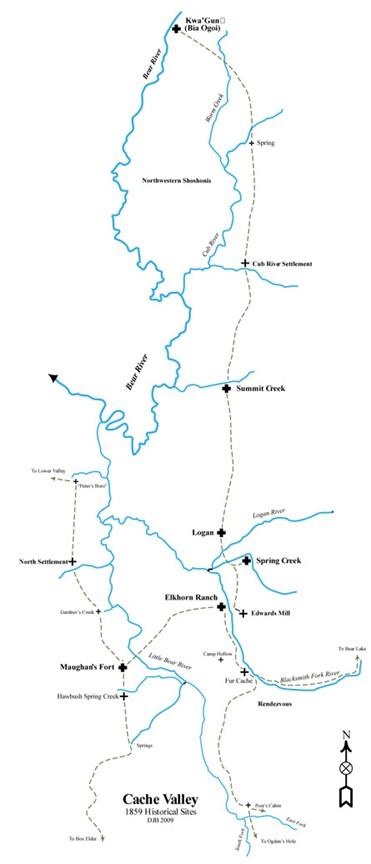
A century and a half has transpired since the settlement on April 20, 1859, of what today is Providence City located two miles south of Logan, Utah.1,2 First called “Spring Creek,” Providence was the second community settlement in Cache Valley following “Maughan’s Fort” (Wellsville) founded September 15, 1856, by Peter Maughan.3 The settlement of northern Utah Territory had resumed in the spring of 1859 after the interruption of the 1858 “Utah War.” Succeeding Providence, the next new communities were “North Settlement” (Mendon) on May 2, 1859,4 and then Logan on June 6, 1859.5 The Logan settlers had been attracted to the Spring Creek site; however, they encountered complications with settlers already there. Consequently, they went north along the East bench to Summit Creek, the subsequent location of Smithfield but turned around and came back to the Logan River to make their settlement. By the end of that first year Logan was already becoming the dominant community in the Valley
The first to arrive in the spring of 1859 at the Spring Creek to settle near the mountains on the east side of Cache Valley were sixty-five- year old Ira Rice and thirty-five-year old Hopkin Mathews with his teenage daughter, Elizabeth. They came up around the mountains from North Ogden, considered to be the “mother” town of Providence.6 The reason the pioneers gave for their move north was that Weber County was “getting too crowded.” Undoubtedly, the compelling motivation was the availability of unclaimed tracts of choice land. Articles by Peter Maughan and Brigham Young in the Deseret News Weekly gave glowing accounts of the Valley.7 The paper advertised excellent ranges with rich soil, abundant water and nearby “there is plenty of timber, consisting chiefly of pine, maple and quakenasp.” 8 Mormon scouts who had earlier explored Cache Valley returned to convey similar accounts. Thusinclined adventurous men were no longer satisfied living in the increasingly compact settlements to the south where the choicest lands had already been taken up. Other factors were drought (prior to the severe 1855 winter) and by cricket infestations in Great Salt Lake Valley and Ogden.9
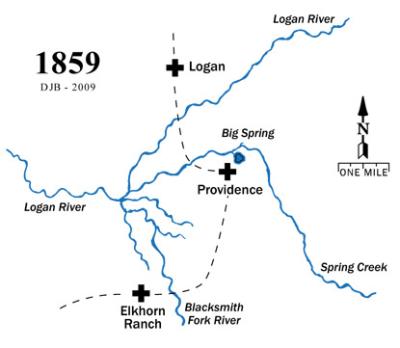
Ira Rice was born in New Ashford, Berkshire, Massachusetts, on October 2, 1793.10 He was orphaned at about the age of five and then lived with relatives in upstate New York. He was five feet eight inches tall, had lightcolored hair and blue eyes. Ira enlisted and served as a private in the Ontario County Regiment during the time of the War of 1812.
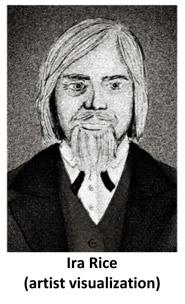
The U.S. Government offered homestead land grants in the wilderness of Michigan to the veterans of the War of 1812. Seizing upon the opportunity, Ira Rice moved to Michigan with his second wife Sarah Ann Harrington, his first wife having died after giving birth to her fifth child.
Ira and Sarah joined the LDS Church about 1840 and then with their family travelled west to the Mississippi River to join the “Saints” at Nauvoo, Illinois. Rice acquired a house and a farm, both of which were lost in 1846 when anti-Mormon mobs drove them out and torched their home.11 Ira and two sons joined the June 17 exodus to Great Salt Lake City where they arrived as part of the Captain Daniel Spencer “First Hundred,” Ira Eldridge “Second Fifty,” George Boyes “Fifth Ten” wagon train on September 19, 1847.12 Next year when the remainder of the large family rejoined Ira coming from Kanesville, Iowa, and Winter Quarters, Nebraska Territory, Ira learned that his wife Sarah had passed away.
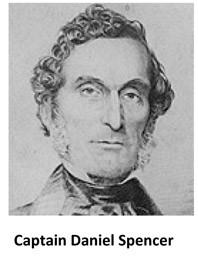
In the spring of 1848, Ira Rice and his eldest son, Asaph, built a rock cottage in “North Cottonwood” which became the town of Farmington in Davis County.13 Soon thereafter (1857), they moved through Ogden (“Brownsville” before 1850) to what became North Ogden. Ira and Asaph built a log cabin on “Rice Creek.” The settlers at North Ogden referred to their community site as “Ogden’s Hole” after the beaver fur trapper from Quebec, Peter Skene Ogden, for whom Ogden River, Ogden Valley, and Ogden City were named.14, 15 However, the actual site of “Ogden’s Hole” has been shown to be Ogden Valley in the mountains to the east about ten miles up Ogden River Canyon where the present-day towns of Liberty, Eden, Huntsville and the Pineview Reservoir are located.16,17
While living in North Ogden, Ira Rice married Elizabeth Ann Morris Butler on November 20, 1856. Known by the name “Ann,” she was the older sister of Hopkin Mathews’ wife Margaret. Thus, Ira and Hopkin became brothers-in-law. Ann was a thirty-nine-yearold widow from Wales who, with her three children, had come across the Plains in the 1856 Bunker Handcart Company.18 She was in dire circumstances and a friend had found employment for her as a housekeeper for Ira Rice’s large family. Ira had become the father of seventeen children and step-father of three more.
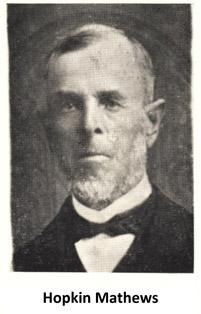
Another original Providence pioneer traveled overland with the Edward Bunker Handcart Company in 1856. Hopkin Mathews and wife Margaret pulled a handcart across the plains. Their four children were three girls and an infant boy.
This Third Company of handcart pioneers was made up almost entirely of Welch emigrants. The Mormons of the “Welch Company” crossed the Atlantic on the Church-chartered ship Sanders Curling.19 The ship sailed out of Liverpool on April 19, 1856, with 707 “Saints” onboard under Dan Jones.20 The vessel landed at Boston, Massachusetts, on May 23. At this time, cholera epidemics had diverted arriving emigrant ships from Liverpool, England, away from New Orleans, Louisiana. From Boston the immigrants rode, sometimes in cattle cars, on a railroad train to New York City, through Chicago, Illinois, and on west to St. Louis, Missouri. They boarded a steamboat up the Mississippi River to Iowa City, Iowa, where they were outfitted with wooden handcarts. From there, they pulled their handcarts to the Missouri River and crossed to Winter Quarters (“Florence”), Nebraska Territory. After taking on provisions and making repairs, on July 30 the “Welch Company” headed west across the Great Plains following the Platte River.21
Hopkin Mathews was born July 13, 1823, at Swansea, South Wales. He was working in the coal mines as a collier when, at nineteen, he joined the LDS Church. Shortly thereafter, he was called to labor as a missionary in South Wales. Hopkin married Margaret Morris on June 17, 1844. It was just ten days before Joseph Smith and his brother were murdered by a mob in Carthage, Illinois. The Mathews couple served together as missionaries until they decided to emigrate to the Mormon “Zion” in America.22
Hopkin Mathews and family, which at the outset included four-month old Alma, endured the never-to-be-forgotten long trek to the West. The Third Handcart Company was led by Mormon Battalion veteran, 34- year-old Edward Bunker. The Company was comprised of 320 people pulling 64 handcarts.23
They left Iowa City, Iowa, on June 28th, 1856, and arrived in the Great Salt Lake Valley on October 2.
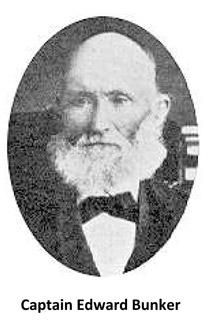
It took over a hundred days to walk some thirteen hundred miles. Each family pulled a twowheeled handcart loaded with a couple of hundred pounds of provisions, supposedly including not more than seventeen pounds of baggage per person. Coffee and bacon soon ran out and food, mostly flour, was in such short supply that it had to be severely rationed the rest of the way. With the lack of grease, there was the continual squeaking of the wheels turning dry on the axles, necessitating continual repairs. Five wagons pulled by mules carried flour and tents. At night, the tents were put up on the ground to sleep as many persons as possible using their coats as padding.
Hopkin was stricken with rheumatism and sometimes had to be pulled in one of the carts. The records show that, luckily, no more than six members of this Third Handcart Company died in crossing the Plains and Rocky Mountains. Two of those who perished were a lighthouse keeper from Wales and his wife. Two of the pioneers who walked nearly all the way were blind, another had only one leg and yet another had one arm.24
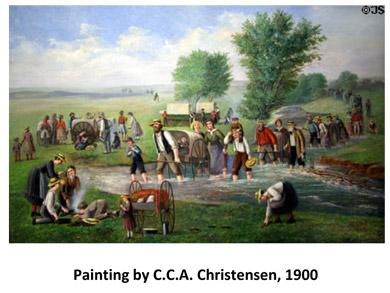
Although The Third Handcart Company of 1856 was not caught in snow, the immigrants were exposed to incessant hunger and to the elements – wind, rain, lightning, cold, heat, dust or mud. They continually had to make difficult crossings of rivers and streams.25 Crossing Iowa they encountered some ridicule by onlookers.
About a week after their welcome into Great Salt Lake City, the Mathews moved to Farmington. After a brief stay they went on north to Ogden, where Captain Bunker had made his home prior to being called on a four-year mission to Great Britain. Hopkin Mathews and son Alma erected cabins for their family in North Ogden. Neighbors included pioneers Ira Rice and the Campbells.
Leaving North Ogden in the early spring of 1859, Ira Rice with Hopkin Mathews and daughter Elizabeth brought their wagons into Cache Valley by the low west “entrance” where the Bear River exits. After visiting with Peter Maughan they stopped over for the night at the Elkhorn Cattle Ranch which was established on the Twenty-fourth of July, 1855, on a spring adjacent to the west bank of the Blacksmith Fork River.26 The next morning, on April 20, 1859, the party crossed the river and arrived at the Spring Creek. They immediately selected a site southwest of “The Big Spring” to stop and camp out of their wagons. The “Spring” fed a pond which added its water to that of the Spring Creek flowing from the nearby canyon. The Spring Creek (Providence) Canyon is located in the Bear River Range between snow-covered “Temple Peak” on the left and “Old Baldy” on the right.
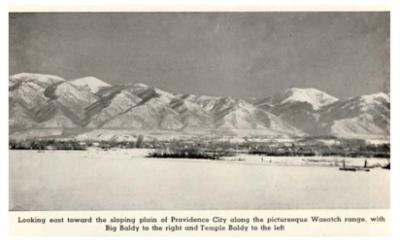
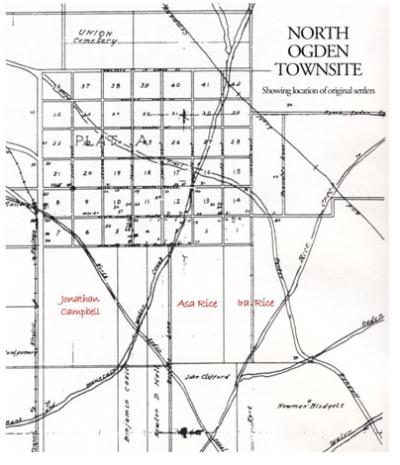
Several days later, Samuel Campbell, 31, and his brother Joseph Hyrum Campbell, 21, arrived only to find Rice and Mathews already living out of their wagon boxes on the land they had purportedly “staked out for themselves” during their exploration two years previously.
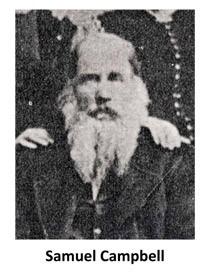
From North Ogden, in the early spring of 1857, Samuel Campbell, his brother Joseph, cousins Aboile and Nephi Campbell accompanied by John Dunn had crossed the mountains on horseback to see Cache Valley.27 Their intention to make a new settlement had been interrupted by the so-called “Utah War.” The Rice and Campbell families had been neighbors in North Ogden and so the three families were able to resolve the situation amicably. In fact, on the first day of 1861, the families were merged as Joseph Hyrum Campbell married Hopkin Mathews’ pretty daughter Elizabeth!28
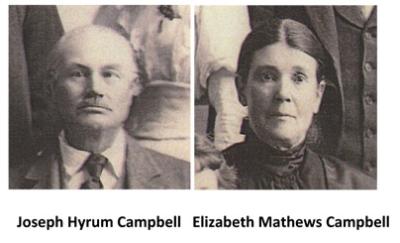
Joseph Hyrum Joseph Hyrum Campbell Elizabeth Mathews Campbell The location of the pioneer camp near the “Big Spring”, where the settlers first lived out of their wagon boxes and dugouts, was north of the subsequent Providence City Block 11 on acreage owned in 1945 by John Francis Astle and John Abersold. At present (2009), the properties are owned by Lloyd Astle Baer and Marlin Hoth, both of Providence.
Samuel Campbell served in the same Company E of the Iowa Mormon Battalion as Edward Bunker. Both enlisted as privates on July 16, 1846, at Council Bluffs, Iowa, and mustered out on July 16, 1847, at Los Angeles.29 He arrived in Great Salt Lake City from California in 1849. The experience of the Battalion members in their military expedition from Iowa to California was of great benefit to Brigham Young as he and the Twelve Apostles chose Captains to organize and lead the Overland Immigration Companies.
Descended from many generations of the Campbell clan in Argyll, Scotland, Samuel was born on May 4, 1827, in Orange County, New York. After being baptized in 1832 into the LDS Church, at nearly the same time and place that Brigham Young joined, Samuel’s parents gathered with other Mormons at Kirtland, Ohio. There on August 15, 1837, one of Samuel’s younger brothers was born. Joseph Smith, Sr., cradled the baby in his arms and christened him “Joseph Hyrum” in honor of the Patriarch’s own two later-to-be martyred sons.30
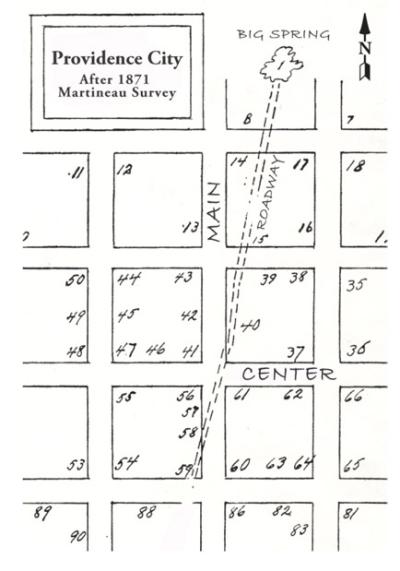
In 1846 the Campbell family left Nauvoo with the “Saints” and began their westward exodus. It was 1850 before they earned enough money to sustain them on the journey to the Great Salt Lake Valley. They outfitted with the Colonel Stephen Markham Company in Kanesville, Iowa, and departed with a train of fifty wagons on the twentieth of June. Barely under way, the Company was stricken with cholera. Mary Leonard Campbell, the mother of Samuel and Joseph and their siblings, died on June 30, 1850. On the Fourth of July father Benoni also passed away. Thirteenyear- old Joseph Hyrum Campbell accompanied by his siblings and uncle Jonathan arrived in Great Salt Lake City on October 1, 1850. 31
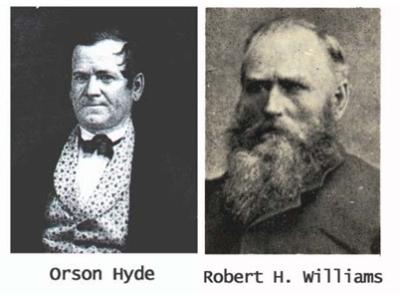
Jonathan and Samuel Campbell and John Riddle32 first settled North Ogden in the fall of 1850. The town is situated about five miles directly north of Ogden. In Cache Valley new-arrivals John Maddison, and William Fife joined with pioneers Ira Rice, Hopkin Mathews, and the Campbells to erect cabins for their families. They laid out a narrow roadway on a diagonal southwest from the “Big Spring.” Douglas fir logs were cut and dragged down from the Canyon to build rough-hewn cabins. The houses were arranged in two rows so that the narrow interior roadway could be closed off at each end in case of hostilities from the native Shoshonis.33 Cedar posts were cut for fencing.
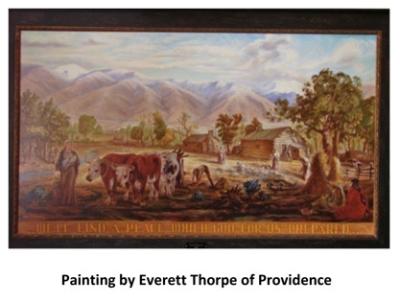
On April 25, Peter Maughan visited Spring Creek. He selected Samuel Campbell to be the presiding elder for the settlement.34 By August there were sixteen families in the makeshift “fort.” On November 14, 1859, LDS apostles Orson Hyde and Ezra Benson came to organize the settlement and set up an ecclesiastical “Ward” under Robert Hanna Williams as bishop. Council of the Twelve President Hyde gave the place a new name: “Spring Creek settlement being situated in an elbow of the mountains and appearing to us somewhat of a providential place, we named Providence.” 35
By the end of the year of the “Great Migration” to Cache Valley, 1859, there were some 29 settlers in Providence who could be classified as “heads of households.” 36
- Eva A. Rice and Loretta C. Rice, Footprints of Ira Rice, D. J. Baker, ed., Utah State University, Logan, Utah; 1973, p. 18.
- Joel E. Ricks, “The First Settlements,” The History of a Valley: Cache Valley Utah Idaho, Joel E. Ricks and Everett L. Cooley, eds., Cache Valley Centennial Commission, Logan, Utah; 1956, p. 39.
- Ricks, op. cit., p. 34.
- Edward W. Tullidge, Northern Utah and Southern Idaho, Tullidge’s Histories, Vol. 2, Juvenile Instructor, Salt Lake City; 1889, p. 422.
- Ricks, op. cit., p. 41.
- Providence and Her People: A History of Providence, Utah, 1857-1974, Providence History Committee, Second Edition: 1974, p. 10.
- Deseret News Weekly, Vol. 5, No. 32; October 17, 1855.
- Deseret News Weekly, Vol. 9, No. 16; June 22, 1859.
- Rex J. Haddock, A History of Cache Valley, Utah, From the Fur Period to the Year 1869, Thesis, Utah State Agricultural College; 1953, p. 16.
- 10. Rice and Rice, op. cit, p. 5, 9.
- 11. Rice and Rice, op. cit., p. 19.
- Kate B. Carter, Heart Throbs of the West, Vol. 8; 1947, p. 423.
- Glen A. Leonard, A History of Davis County, Utah State Historical Society; 1999, p. 24.
- Archie Binns, Peter Skene Ogden: Fur Trader, Binfords & Mort, Portland; 1967, p. 139.
- Richard C. Roberts and Richard W. Sadler, A History of Weber County, Utah State Historical Society; 1997, p. 24.
- Floyd J. Woodfield and Clara Williams Woodfield, eds., A History of North Ogden: Beginnings to 1985, North Ogden History Committee; North Ogden; 1985, p. 3.
- David E. Miller, Utah History Atlas, Smith Secretarial Service, Salt Lake City; 1968.
- LeRoy R. Hafen and Ann W. Hafen, Handcarts to Zion, Arthur H. Clark Co., Glendale; 1960, p. 287. Also, Merrill Lofthouse et al., Hopkin Mathews Family: From South Wales to Utah by Handcart in 1856, Printed by Office Depot, Salt Lake City; 2002.
- Pioneer Pathways, Daughters of Utah Pioneers, Vol. 9; 2006, p. 182. An often repeated error calls the sailing ship “Samuel Curling.”
- Hafen and Hafen, op. cit., p. 88.
- Gaylen K. Bunker, The Annotated Edward Bunker: A Study in Commitment and Leadership, Gainbridge Classic, Salt Lake City; 2000, Chpt. 8.
- Doran Baker, Clyde Braegger and Glenn Allred, A Providential Place, Cache Valley Historical Society and Utah State University, Logan; 1975.
- Hafen and Hafen, op. cit., p. 193,
- Kate B. Carter, ed., Our Pioneer Heritage, Vol. II, Daughters of Utah Pioneers, Salt Lake City; 1949, p. 38.
- Will Bagley “One Long Funeral March: A Revisionist’s View of the Mormon Handcart Disaster.” Mormon History, Vol. 35, No. 1; 2009, p. 69.
- Henry Stringham and Nathaniel Stringham, Briant Stringham and His People, Stevens and Wallis Press, Salt Lake City; 1949, p. 26.
- Baker et al., p. 11.
- Hyrum A. Campbell, ed., Providence and Her People, The Historical Society of Providence, Providence, Utah; 1949. P. 8.
- 29. Iowa Mormon Battalion, Company E,” Roster of Iowa Soldiers, miscellaneous, Vol. 6, Des Moines, 1911, p. 3.
- Phillip Glenn Wheeler, “Benoni Campbell;” December, 1888. Lily Eleanor Campbell, ed., Society of Utah Pioneers; 1986, p. 3.
- Ibid
- Woodfield and Woodfield, op. cit, p. 6.
- Doran J. Baker, “Providence,” Utah History Encyclopedia, Allan Kent Powell, ed., University of Utah Press; 1994, p. 446.
- Baker et al., op. cit, p. 24.
- Orson Hyde and Ezra T. Benson, Deseret News Weekly, Vol. 9, Nov. 30, 1859, p. 309.
- Baker et al., op. cit., p. 41.
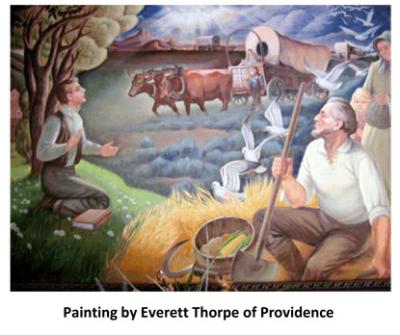
Acknowledgements
The contributions of Kathy Baker, Kellyn Bailey, Jennifer Schultz and Kimberly Olson are recognized. Doran Baker is a lifetime member of the Utah Historical Society and is an Adjunct Professor in the Department of History at the Utah State University of Agriculture and Applied Science. Dr. and Mrs. Baker have made Providence their home for many years, and Kathy presently serves on the Providence City Council. Robert Parson, University Archivist, USU Special Collections & Archives, is writing Providence and Her People, third edition, targeted for publication in late 2009.
